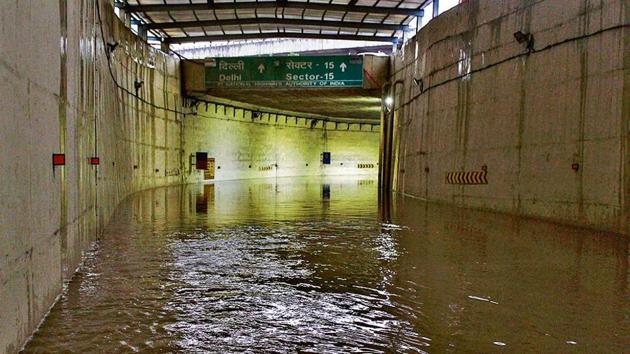Technical issues, water backflow cause flooding of Gurugram’s Rajiv Chowk underpass
The 708-metre underpass had opened two years ago, on August 14. It allows commuters travelling from Bakhtawar Chowk to head directly towards Delhi and bypass the congested Rajiv Chowk.
Following 55mm of rain on Tuesday evening, the Rajiv Chowk underpass near Medanta Hospital was shut for five hours due to the accumulation of water inside it.

Officials of the Gurugram Metropolitan Development Authority (GMDA) and the National Highways Authority of India (NHAI) on Wednesday cited various reasons, such as blocked drainage channels, failure of a motor pump, unchecked flow of rainwater from nearby areas, recent construction of a speed breaker for the flooding.
However, officials of both agencies said that they are yet to formulate a permanent solution to the issue.
The 708-metre underpass had opened two years ago, on August 14. It allows commuters travelling from Bakhtawar Chowk to head directly towards Delhi and bypass the congested Rajiv Chowk.
Unchecked flow of rainwater from nearby residential areas
NHAI officials said that since the underpass is situated at the lowest point in the area, rainwater from nearby residential areas of sectors 32, 38 and 47 largely flows undeterred towards it, as none of the arterial drains in these sectors is interlinked or connected to the Huda master drains.
“If the arterial drains are interlinked and connected to the master drains, it will reduce the volume of rainwater flowing towards the underpass each time there is heavy rainfall. Provided the drains are linked and connected to master lines, the volume of rainwater towards the underpass can be managed without any problem,” said Saurabh Singhal, consultant, NHAI.
Singhal said that there are four motor pumps of 20 horsepower (HP) each inside the underpass that cleared the rainwater late Tuesday.
“We closed the underpass around 6.15pm on Tuesday. It was only around 9pm that rainwater coming from the direction of Medanta Chowk at the entrance of the underpass and Rajiv Chowk, on the other end, stopped flowing. Subsequently, the motor pumps cleared the rainwater accumulated inside the underpass within two hours. After verifying there was no silt deposition or muck, we opened the underpass at 11.30pm,” said Singhal.
Failure of motor pump
Lalit Arora, the chief engineer of GMDA, said that a motor pump, with a capacity of pumping out 20 cusecs of rainwater, installed by the NHAI at the Tau Devi Lal Stadium did not function, which resulted in the flooding of the underpass.
“Whenever the motor pump operated by the NHAI encounters any problem, it results in flooding of the Rajiv Chowk underpass. It was the failure of the motor pump to function that was the main cause of rainwater accumulation inside the underpass,” said Arora.
Ashok Sharma, the project director of NHAI, did not respond to requests for comment on the allegation.
Construction a speed breaker nullifies NHAI’s elevation of the surface road before the underpass
NHAI officials said that the construction of a speed breaker at the entrance of the Tau Devi Lal Stadium, by GMDA last month, located adjacent to the underpass has made the engineering work carried out by them last October last year redundant.
The NHAI had raised a 10.5-metre portion of the surface roads leading to the underpass by two metres to ensure it has a height greater than that of adjacent CH Bakhtawar Singh Road, to check the flow of rainwater towards the underpass.
“We can only raise the level of the road by two metres, as any further elevation would have hindered traffic movement significantly and caused congestion. The recent construction of a speed breaker at the entrance of the stadium resulted in large amount rainwater flowing backwards, towards the underpass, which meant that our efforts were largely nullified,” said Singhal.
In addition, NHAI officials also said that the stormwater drains on CH Bakhtawar Singh Road located next to the underpass have also not been properly desilted by the GMDA, resulting in a lack of an outlet for rainwater to flow towards.
Arora countered this claim and said that drains along the CH Bakhtawar Singh Road had been desilted prior to monsoon.
Blocked drainage
Nearly a year after its opening, GMDA officials realised that when the underpass was constructed, the underground drainage lines had been inadvertently blocked. As a result, there was no direct outlet for rainwater to flow.
The mistake was only realised after the Rajiv Chowk underpass was flooded in July 2018. Arora said that a new drainage line, adjacent to the blocked channel, was placed last year.
“The blocked channel was observed last year and remedial measures were accordingly undertaken. We have created a new drainage channel adjacent to the previous one,” said Arora.
Stay updated with all the Breaking News and Latest News from Mumbai. Click here for comprehensive coverage of top Cities including Bengaluru, Delhi, Hyderabad, and more across India along with Stay informed on the latest happenings in World News.
Stay updated with all the Breaking News and Latest News from Mumbai. Click here for comprehensive coverage of top Cities including Bengaluru, Delhi, Hyderabad, and more across India along with Stay informed on the latest happenings in World News.






